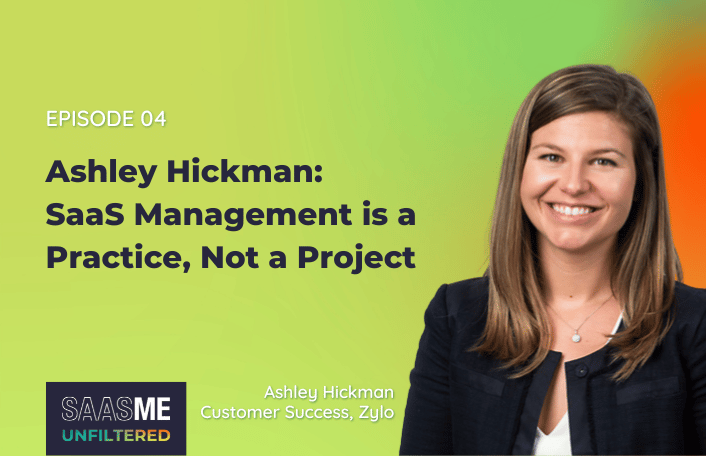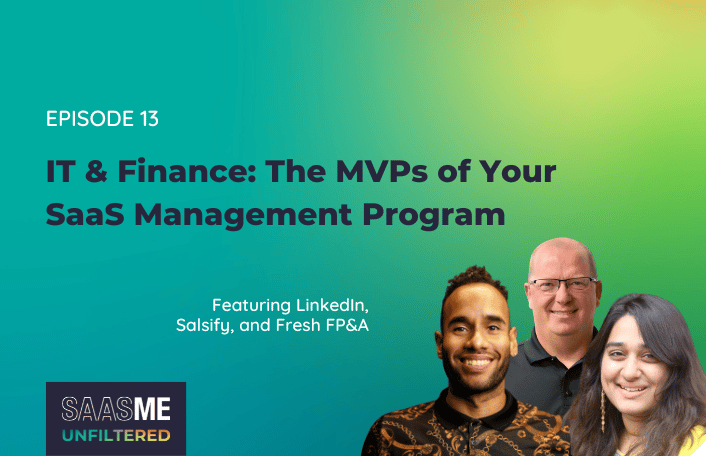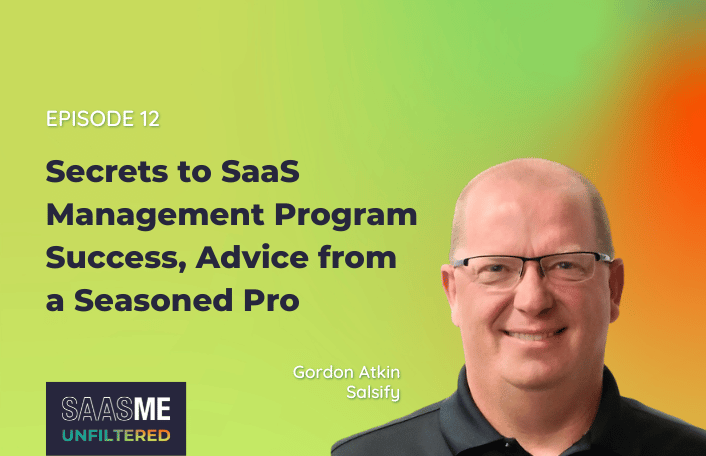
Ashley Hickman: SaaS Management is a Practice, Not a Project
Table of Contents ToggleEpisode SummaryGuest SpotlightEpisode HighlightsIT No Longer Manages EverythingSaaS...
Back
Back
Search for Keywords...
Blog

12/01/2022
Table of Contents
The days of IT handling all software purchases are long gone. These days, business units own a staggering 65% of SaaS spend and 40% of application quantity. Clearly, Saas has permeated every part of the business, and managing it requires cross-functional collaboration.
IT and Finance leaders at today’s most progressive organizations get it. In this episode of SaaSMe Unfiltered, recorded live at SaaSMe 2022, leaders at LinkedIn, Salsify, and Fresh FP&A discussed how they’re fostering alliances across their organizations to drive maximum impact with SaaS.
Listen to the full episode on Spotify and Apple Podcasts.
SaaS is growing – and will only continue to do so. Gartner predicts SaaS expenditures will grow 19% year-over-year, despite the current economic climate.
In the midst of this growth, SaaS management has become increasingly important. But it’s not the sole responsibility of a single person or department. Rather, SaaS management is a team sport. You simply can’t expect to hit your SaaS management goals unless key players are working together.
“I think that when you bring together more and try to operate as one versus one trying to operate as many, there’s much more power in that,” said Gordon Atkin, VP of Technology and Business Platform at Salsify
Strong collaboration starts at the top. In fact, executive buy-in is key.
“The first thing that comes to mind is executive sponsorship. That has to be there. It’s the biggest win, if you can get it,” said Shravya Ravi, Manager, Asset Management at LinkedIn.
Then, you must convey why SaaS management matters – and what’s in it for each of your key players.
“If you want to move fast, go alone. If you want to move further, go together. Those are the conversations. You’ve got to get down with the business and speak their language. It’s about connecting the dots between why it’s important, what’s in it for the business partner, and here’s where we’re going together,” said Chris Ortega, Chief Executive Officer at Fresh FP&A.
Name: Gordon Atkin
What he does: VP of Technology and Business Platform at Salsify
Connected with Gordon online: LinkedIn
Name: Shravya Ravi
What she does: Manager, Asset Management at LinkedIn
Connected with Shravya online: LinkedIn
Name: Chris Ortega
What he does: Chief Executive Officer at Fresh FP&A
Connected with Chris online: LinkedIn
“There are two words that come to mind when I think about running SaaS. One is transparency. I want to have transparency and visibility across the entire organization in terms of what we’re spending our money on. Most departments know what they’re spending their money on, but CFOs, IT leaders, procurement leaders, there are lots of people in the company that need visibility and transparency into what’s going on. The second word that comes to mind is discipline. Recognizing, again, how much money is spent on software, SaaS specifically, within organizations. We need to have discipline.” – Gordon
“The transparency, the visibility is what’s most important. Because when you look at app owners, they actually know what they’re spending money on. But there might be three other app owners spending the same money on the same thing. We just need to get that visibility throughout the organization. So the first goal is to get visibility. That helps organizations make better-informed business decisions.” – Shravya
“When you look at opportunities to make an immediate impact, people is typically the first place that a lot of traditional CFOs go to. But one thing that I’ve seen is the ability to centralize your SaaS spend, and really operationalize it, and really get your hand around it, and getting to this overall topic. And bringing in your IT, bringing in your HR, bringing in your marketing. Bringing in the other functional areas to be part of the conversation to say, ‘What makes the most sense for our organizations, both around SaaS spend, but where do we have opportunities to streamline, to scale, and to optimize that?’ This is one of the biggest opportunities that CFOs have to really make that immediate cashflow impact in their business, and it’s traditionally not the first place that people go.” – Chris
“One of the things that I think CFOs and others care about is, they do care a lot about managing risk. And until you know what your footprint and what your exposure is, it’s hard to really know where your risk and where you’re exposed. Especially from a security perspective. You might have applications where there’s personal information that’s being shared, and you don’t know about it. So there is a component of risk that I think CFOs do care about, that they want to make sure that it’s being mitigated and managed properly too.” – Gordon
“We also work with our security organization to bring up expense software that has not been through a security review. I think that’s a big win, at least for the risk side of things. Everyone cares about the unknown risk.” – Shravya
“It has to be a highly, highly collaborative initiative. It can’t be done in a silo. I think the first thing that comes to mind is executive sponsorship. That has to be there. It’s the biggest win, if you can get it. Once you do have that executive sponsorship, then it further sets into motion whatever work that we can do with finance teams. That is one team that we work with closely for budget monitoring. What’s budgeted, what is our spend looking like? And taking that information and passing that on to our procurement sourcing and vendor management teams. That is another critical area, because they work closely with legal, which impacts how our contracts are being written down. Also, we work very closely with application owners. We can’t go after every single application owner. The 80/20 rule, where 80% of your spend is on 20% of your vendors. We go after the top ones.” -Shravya
“There’s three key personas that I look for. Number one is the FP&A persona. Who, at that level, is going to really help us understand the spend from a budget perspective? The second key persona I would say is procurement. And procurement I’ll use very broadly, because there’s a lot to it. There’s the negotiation side of it. There’s the renewal side of it. And there’s just, how do you manage contract terms and conditions and things like that? And then the third persona, I will say, is more of a broad persona. It’s what I’ll call the stakeholder persona. I try to enlist as many people as I possibly can. I think that when you bring together more and try to operate as one versus one trying to operate as many, there’s much more power in that.” – Gordon
“There’s a classic analogy I always use when I lead finance organizations. If you want to move fast, go alone. If you want to move further, go together. Those are the conversations. You’ve got to get down with the business and speak their language. It’s about connecting the dots between why it’s important, what’s in it for the business partner, and here’s where we’re going together.” -Chris
“Go look at the bills, go look at the money, go follow the money. One action item that I give every CFO right now, ‘If you want to start getting a handle on your SaaS spend, go deep dive into your accounts payable.’” – Chris
“The first answer we usually get is, ‘We don’t have resources.’ But it’s also important that we talk about why we’re doing what we are doing, and how it’s going to impact how we do business. For me, it’s always, first, executive sponsorship. Second, once you actually have executive sponsorship, it’s a prioritization exercise. How high up in the priority list are we? Sometimes not always at the top, but I think, depending on the stakeholder, we get there. Sometimes it’s a waiting game.” – Shravya
“I think what you’re seeing is this transition from an IT-led, or even a procurement-led, to SaaS management being a cross-functionally led effort. In fact, I had one of my FP&A leaders set up a meeting with me, and the title of the meeting was ‘SaaS Management, What are We Going to Do?’ This wasn’t me going out and saying, ” What are we going to do?” But it was the FP&A leader, and that was the first experience that I had somebody non-IT who was really leading that charge and that conversation. So I really feel that you’re starting to see that transition of it becoming much more important, not just to IT, not just to finance, but it is coming across the entire organization. And I really believe that executive sponsorship is really important.” – Gordon
“With the macroeconomics and everything else happening outside of this, you’ve got to pay attention. You have to start looking at the data. You have to tell a story using the data. And it’s very, very important that something come out of the data that you are looking at. That’s where I see, at least for the next one year, everyone’s going to start paying attention. But it’s also what you’re going to be doing with whatever you are seeing. I think that’s important. Starting thinking about it in a big-picture way.” – Shravya
“This is a tremendous time for the office of the CFO and finance leaders to really bring a tremendous legacy. Finally, we have the opportunity to give the business what they need. We need to be great collaborators. We need to be great communicators of the strategies and tactics that we’re implementing. We need to bring clarity to our software SaaS spend, and lastly, build that connection inside the organization.That’s what the business has always demanded. And now, it’s our opportunity to meet that demand and over-exceed. Bring that collaboration, that communication, that complexity, and driving clarity, and also that connection. That’s our task.” – Chris
12:02 – “Managing your SaaS spend is not just a short-term, ‘Well, put a BAND-AID on it.’ This is a long-term strategy.” – Chris
26:28 – “Get down with the business. Get funky with the business.” – Chris
13:46 – “It has to be a highly, highly collaborative initiative. It can’t be done in a silo” – Shravya
6:51 – “The transparency, the visibility is what’s most important.” – Shravya
18:00 – “I think that when you bring together more and try to operate as one versus one trying to operate as many, there’s much more power in that.” – Gordon
25:14 – “I really believe that executive sponsorship is really important.” – Gordon
Listen and subscribe to SaaSMe Unfiltered wherever you listen to podcasts.
ABOUT THE AUTHOR

Cory Wheeler
As Zylo’s Chief Customer Officer, Cory is responsible for helping our customers drive ROI and SaaS Management success with Zylo. He helps companies of all sizes effectively discover, optimize, and govern their SaaS through Zylo’s platform and services. Prior to founding Zylo, Cory spent 15 years in finance and procurement, managing categories and sourcing teams at Arthur Andersen, BearingPoint, and both Takeda and Astellas Pharmaceuticals. He built the procurement organization at ExactTarget, and managed the integration with the Salesforce Marketing Cloud procurement organization in 2015. He and his family reside in Indianapolis, IN, where they can be found cheering for the Purdue Boilermakers and Chicago Cubs.

Table of Contents ToggleEpisode SummaryGuest SpotlightEpisode HighlightsIT No Longer Manages EverythingSaaS...

Table of Contents ToggleEpisode SummaryGuest SpotlightEpisode HighlightsThere are Inherent Risks with...

Table of Contents ToggleEpisode SummaryGuest SpotlightEpisode HighlightsFor a CIO, Taking a...

Table of Contents ToggleEpisode SummaryGuest SpotlightEpisode HighlightsUncovering the Impact of SaaS...
| Cookie | Duration | Description |
|---|---|---|
| cookielawinfo-checkbox-analytics | 11 months | This cookie is set by GDPR Cookie Consent plugin. The cookie is used to store the user consent for the cookies in the category "Analytics". |
| cookielawinfo-checkbox-functional | 11 months | The cookie is set by GDPR cookie consent to record the user consent for the cookies in the category "Functional". |
| cookielawinfo-checkbox-necessary | 11 months | This cookie is set by GDPR Cookie Consent plugin. The cookies is used to store the user consent for the cookies in the category "Necessary". |
| cookielawinfo-checkbox-others | 11 months | This cookie is set by GDPR Cookie Consent plugin. The cookie is used to store the user consent for the cookies in the category "Other. |
| cookielawinfo-checkbox-performance | 11 months | This cookie is set by GDPR Cookie Consent plugin. The cookie is used to store the user consent for the cookies in the category "Performance". |
| viewed_cookie_policy | 11 months | The cookie is set by the GDPR Cookie Consent plugin and is used to store whether or not user has consented to the use of cookies. It does not store any personal data. |
